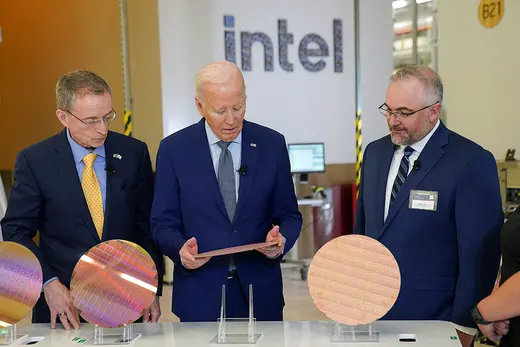In Brief
What Is the CHIPS Act?
Extraordinary U.S. government incentives are proving popular with many large chipmakers, but it is too early to tell how much of the semiconductor industry can be lured back to the United States.
The CHIPS and Science Act marks a substantial ramp-up of industrial policy in the United States. The legislation is sparking a great deal of investment activity in the U.S. semiconductor sector, but several challenges and potential pitfalls lie ahead.
Supporters see the policy—and the far-larger Inflation Reduction Act [PDF]— as a much-needed investment in critical technologies at a time of growing geopolitical friction and climate change. However, some critics fault them for attempting to pick winners and losers in the marketplace, expanding the federal debt, and pursuing too many policy objectives.
Defining the CHIPS Act
More on:
Signed into law in August 2022, the Creating Helpful Incentives to Produce Semiconductors (CHIPS) and Science Act is intended to lure microchip manufacturing back to the United States after several decades of individual companies offshoring the technology. Although the country produced close to 40 percent of the world’s semiconductor supply in 1990, that statistic has slipped to just 12 percent. Taiwan, on the other hand, produces more than 60 percent of the world’s supply of semiconductors and more than 90 percent of the most advanced chips. The United States does not produce any higher-end chips today.
The CHIPS Act allocated $53 billion in federal incentives for domestic semiconductor manufacturing and research and development, of which $39 billion is set aside [PDF] for a financial assistance program—also called the CHIPS for America Fund—administered by the U.S. Department of Commerce to build new and expand existing semiconductor facilities. Companies are also eligible for a 25 percent tax credit. U.S. and foreign companies with facilities in the United States are eligible for the federal incentives.
The Act’s Effects Thus Far
The CHIPS Act has generated a flurry of business activity. Hundreds of companies have submitted statements of interest and requested more than $70 billion in subsidies—nearly double the amount available. Companies have meanwhile announced more than $200 billion in private sector investments since the law passed, even as the Commerce Department is just beginning to dole out subsidies. Building new chip manufacturing facilities comes with a hefty price tag. A new facility can cost more than a nuclear power plant—ranging in price from $5 billion to $20 billion.
The first CHIPS grant, totaling $35 million, went to BAE Systems—a UK-based defense contractor—in December 2023 to produce chips for F-15 and F-35 fighter jets. Intel, the American chipmaking giant, was approved in March 2024 to receive $8.5 billion in grants and $11 billion in loans—the largest grant awarded to a chipmaker. Intel previously announced it would invest $100 billion over five years to build new U.S. facilities. Taiwan Semiconductor Manufacturing Company (TSMC) will receive $6.6 billion in grants and $5 billion in loans to support three fabrication plants in Arizona. TSMC’s plans to invest $65 billion in the United States marks the largest foreign direct investment in a greenfield project in U.S. history.
The Joe Biden administration says that those and other investments put the United States on track to meet the near-term goal of manufacturing 20 percent of the world’s most advanced chips by the end of the decade.
More on:
Challenges Ahead
Some experts believe a CHIPS Act II or CHIPS Act III could be needed to completely revitalize the U.S. semiconductor industry and compete with inducements in foreign markets. The European Union passed a similar policy—the European Chips Act—just last year, which puts €43 billion into the bloc’s industry through the end of the decade. China, on the other hand, has invested billions in the industry year after year—not to mention in other technologies such as artificial intelligence—though it too is heavily reliant on TSMC.
Delays or disruptions to projects are also likely. TSMC and Intel have already delayed the opening of their facilities, pointing to higher costs for construction and issues with their suppliers. Another challenge facing semiconductor companies hoping to break ground in the United States is the current lack of a trained workforce.
Some U.S. partners, businesses, and industry analysts have criticized the requirements and conditions the U.S. government has tied to the CHIPS incentives. South Korea’s trade, industry, and energy minister last year, for example, took issue with stipulations he saw as atypical, including the need to submit business management information and childcare plans for their employees. Also, under the terms of CHIPS Act, chipmakers who are awarded funding are restricted from expanding their facilities in China and other “countries of concern” for ten years.
 Online Store
Online Store

